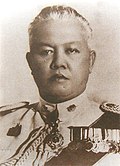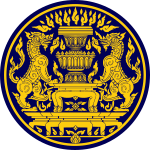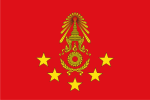Plaek Phibunsongkhram
Field Marshal Plaek Phibunsongkhram (Thai: แปลก พิบูลสงคราม [plɛ̀ːk pʰí.būːn.sǒŋ.kʰrāːm]; alternatively transcribed as Pibulsongkram or Pibulsonggram; 14 July 1897 – 11 June 1964), locally known as Marshal P. (Thai: จอมพล ป.;[tɕɔ̄ːm.pʰōn.pɔ̄ː]), contemporarily known as Phibun (Pibul) in the West, was a Thai military officer and politician who served as the Prime Minister of Thailand and dictator from 1938 to 1944 and 1948 to 1957.
Plaek Phibunsongkhram | |
|---|---|
แปลก พิบูลสงคราม | |
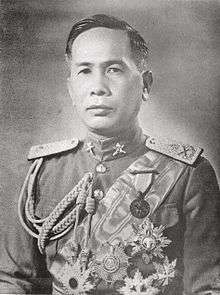 | |
| Prime Minister of Thailand | |
| In office 8 April 1948 – 16 September 1957 | |
| Monarch | Bhumibol Adulyadej |
| Preceded by | Khuang Aphaiwong |
| Succeeded by | Pote Sarasin |
| In office 16 December 1938 – 1 August 1944 | |
| Monarch | Ananda Mahidol |
| Preceded by | Phraya Phahonphonphayuhasena |
| Succeeded by | Khuang Aphaiwong |
| Minister of Defence | |
| In office 28 June 1949 – 26 February 1957 | |
| Prime Minister | himself |
| Preceded by | Suk Chatnakrob |
| Succeeded by | Sarit Thanarat |
| In office 22 September 1934 – 15 November 1943 | |
| Prime Minister | Phot Phahonyothin himself |
| Preceded by | Phot Phahonyothin |
| Succeeded by | Pichit Kriengsakpichit |
| Minister of Foreign Affairs | |
| In office 15 December 1941 – 19 June 1942 | |
| Prime Minister | himself |
| Preceded by | Direk Jayanama |
| Succeeded by | Luang Wichitwathakan |
| Minister of Agriculture and Cooperatives | |
| In office 12 September 1957 – 16 September 1957 | |
| Prime Minister | himself |
| Preceded by | Siri Siriyothin |
| Succeeded by | Wiboon Thammaboot |
| Minister of Culture | |
| In office 12 September 1957 – 16 September 1957 | |
| Prime Minister | himself |
| Preceded by | position establish |
| Succeeded by | Pisan Sunavinvivat |
| Minister of Commerce | |
| In office 4 February 1954 – 23 March 1954 | |
| Prime Minister | himself |
| Preceded by | Boonkerd Sutantanon |
| Succeeded by | Siri Siriyothin |
| Minister of Finance | |
| In office 13 October 1949 – 18 July 1950 | |
| Prime Minister | himself |
| Preceded by | Prince Vivatchai Chaiyant |
| Succeeded by | Chom Jamornmarn |
| Minister of Interior | |
| In office 13 October 1949 – 18 July 1950 | |
| Prime Minister | himself |
| Preceded by | Thawan Thamrongnawasawat |
| Succeeded by | Chuang Kwancherd |
| Minister of Education | |
| In office 1942–1942 | |
| Prime Minister | himself |
| Preceded by | Sindhu Kamolnavin |
| Succeeded by | Prayun Phamonmontri |
| Supreme Commander of the Armed Forces | |
| In office 13 November 1940 – 24 November 1943 | |
| Preceded by | position established |
| Succeeded by | Sarit Thanarat |
| Commander in Chief of the Royal Thai Army | |
| In office 4 January 1938 – 5 August 1944 | |
| Preceded by | Phraya Phahonphonphayuhasena |
| Succeeded by | Phichit Kriangsakphichit |
| Personal details | |
| Born | Plaek Khittasangkha 14 July 1897 Mueang Nonthaburi, Nonthaburi, Siam |
| Died | 11 June 1964 (aged 66) Sagamihara, Kanagawa, Japan |
| Nationality | Thai |
| Political party | Seri Manangkhasila Party (1955–57) |
| Other political affiliations | Khana Ratsadon (1927–54) |
| Spouse(s) | La-iad Bhandhukravi |
| Children | 6, including Nitya |
| Signature | |
| Military service | |
| Allegiance | |
| Branch/service | |
| Years of service | 1914–1957 |
| Rank | |
| Commands | Supreme Commander |
| Battles/wars |
|
Phibunsongkhram was a member of the Royal Siamese Army wing of Khana Ratsadon, the first political party in Thailand, and a leader of the Siamese revolution of 1932 transforming Thailand from an absolute monarchy to a constitutional monarchy. Phibun became the third Prime Minister of Thailand in 1938 as Commander of the Royal Siamese Army, established a de facto military dictatorship inspired by the Italian fascism of Benito Mussolini, promoted Thai nationalism and sinophobia, and allied Thailand with Imperial Japan in World War II. Phibun launched a modernization campaign known as the Thai Cultural Revolution that included a series of cultural mandates, changing the country's name from "Siam" to "Thailand", and promotion of the common Thai language.
Phibun was ousted as Prime Minister by the National Assembly in 1944 and replaced by members of the Free Thai Movement until returning to power in the Siamese coup d'état of 1947 led by the Coup Group. Phibun aligned Thailand with anti-communism in the Cold War, entered the Korean War under the United Nations Command, and abandoned fascism for a façade of democracy. Phibun's second term as Prime Minister was plagued by political instability and was subject to several attempted coup d'etats to remove him including the Army General Staff plot in 1948, the Palace Rebellion in 1949, and the Manhattan Rebellion in 1951. Phibun attempted to transform Thailand into a electoral democracy from the mid-1950s, but was overthrown in 1957 and entered exile in Japan where he died in 1964.
Phibun is the longest serving Prime Minister of Thailand to-date at 15 years and one month.
Early years

Plaek Khittasangkha (Thai: แปลก ขีตตะสังคะ [plɛ̀ːk kʰìːt.tà.sǎŋ.kʰá]) was born on 14 July 1897 in Mueang Nonthaburi, Nonthaburi Province in the Kingdom of Siam to Keed Khittasangkha and his wife.[1] Plaek's paternal grandfather was said to be a Cantonese-speaking Chinese immigrant. However, the family was completely assimilated as Thai and Plaek did not show any features deemed to be typical of ethnic Chinese,[2] which is why he could later successfully conceal and deny his Chinese roots.[3] Plaek's parents owned a durian orchard and he received his given name – meaning 'strange' in English – because of his unusual appearance as a child. Plaek Khittasangkha studied at Buddhist temple schools, then was appointed to Chulachomklao Royal Military Academy. He graduated in 1914 and was commissioned a second lieutenant in the artillery. Following World War I, he was sent to study artillery tactics in France. In 1928, as he rose in rank, he received the noble title Luang from King Prajadhipok and became known as Luang Phibunsongkhram. He would later drop his Luang title, but permanently adopted Phibunsongkhram as his surname.
1932 revolution
In 1932, Phibun was one of the leaders of the Royal Siamese Army branch of the Khana Ratsadon (People's Party), a political organization that staged a coup d'état which overthrew the absolute monarchy in Siam and replaced it with a constitutional monarchy. Phibun, at the time a lieutenant colonel, quickly rose to prominence in the military as a "man-on-horseback".[4] The 1932 coup was followed by the nationalization of some companies and increasing state control of the economy.
The following year, Phibun and allied military officers successfully crushed the Boworadet Rebellion, a royalist revolt led by Prince Boworadet. While King Prajadhipok was not involved in the rebellion, it marked the beginning of a slide which ended in his abdication and replacement by King Ananda Mahidol in 1935. The new king was still a child studying in Switzerland, and parliament appointed Colonel Prince Anuwatjaturong, Lieutenant Commander Prince Aditya Dibabha, and Chao Phraya Yommaraj (Pun Sukhum) as his regents.
Prime Minister of Thailand
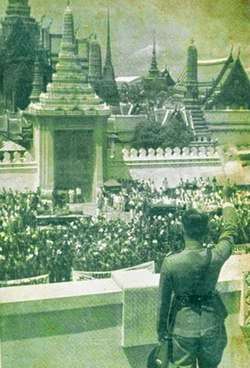
First premiership
On 16 December 1938, Phibun replaced Phraya Phahol as the Prime Minister of Thailand and as the Commander of the Royal Siamese Army. Phibun became the de facto dictator of Thailand and established a military dictatorship, consolidating his position by rewarding several members of his own army clique with influential positions in his government.
After the revolution of 1932, the Thai government of Phraya Phahol was impressed by the success of the March on Rome of Benito Mussolini's Italian Fascism movement. Phibun also seemed to be an admirer of the Italian fascism and sought to imitate the fascist Italian regime's cinema propaganda, valued as one of the most powerful propaganda instruments of Italian political power. Its main purpose was to promote the ideologies of nationalism and militarism, strengthening the unity and harmony of the state, and glorifying the policy of ruralisation in Italy and abroad. With the pro-fascist leanings of Thai political leaders, Italian propaganda films including newsreels, documentaries, short films, and full-length feature films, such as Istituto Luce Cinecittà, were shown in Thailand during the interwar period. Phibun adopted the Italian-style fascist salute, modeled on the Roman salute, and he used it during speeches. The salute was not compulsory in Thailand, and it was opposed by Luang Wichitwathakan and many cabinet members as they believed it inappropriate for Thai culture. Together with Wichitwathakan, the Minister of Propaganda, he built a leadership cult in 1938 and thereafter. Photographs of Phibun were to be found everywhere, and those of the abdicated King Prajadhipok were banned. His quotes appeared in newspapers, were plastered on billboards, and were repeated over the radio.
Thai Cultural Revolution
Phibun immediately prioritized Thai nationalism to the point of ultranationalism, and to support this policy he launched a series of major reforms known as the Thai Cultural Revolution to increase the pace of modernisation in Thailand. His goal "Aimed to uplift the national spirit and moral code of the nation and instilling progressive tendencies and a newness into Thai life". A series of cultural mandates were issued by the government. These mandates encouraged all Thais to salute the flag in public places, know the new national anthem, and use the standardized Thai language, not regional dialects or languages. People were encouraged to adopt Western attire as opposed to traditional clothing styles. Similarly, people were encouraged to eat with a fork and spoon, rather than with their hands as was customary in Thai culture at the time. Phibun saw these policies as necessary, in the interest of progressivism, to change Thailand in the minds of foreigners from an undeveloped country into a civilised and modern one.[5]
Phibun's administration encouraged economic nationalism and espoused staunchly anti-Chinese sentiment despite his own Chinese ancestry. Sinophobic policies were imposed by the government to reduce the economic power of Siam's Chinese minority and encouraged the Thai people to purchase as many Thai products as possible. In a speech in 1938, Luang Wichitwathakan, himself of Chinese ancestry, followed Rama VI's book Jews of the East in comparing the Chinese in Siam to the Jews in Germany, who at the time were harshly repressed.
On 24 June 1939, Phibun changed the country's official English name from "Siam" to "Thailand" at Wichitwathakan's urging. The name "Siam" was an exonym of unknown and probably foreign origin, which conflicted with Phibun's nationalist policies.
In 1941, in the midst of World War II, Phibun decreed 1 January as the official start of the new year instead of the traditional Songkran date on 13 April.
Franco-Thai War
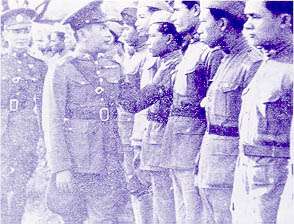
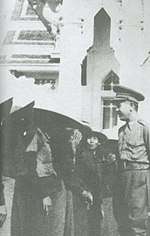
Phibun exploited the Fall of France in June 1940 and the Japanese invasion of French Indochina in September 1940 to advance Thai interests in French Indochina following a border dispute with France. Phibun believed Thailand could recover territories ceded to France by King Rama V because the French would avoid armed confrontation or offer serious resistance. Thailand fought against Vichy France over the disputed areas from October 1940 to May 1941. The technologically and numerically superior Thai force invaded French Indochina and attacked military targets in major cities. Despite Thai successes, the French tactical victory at the Battle of Ko Chang prompted intervention from the Japanese, who mediated an armistice where the French were forced to cede the disputed territories to Thailand.
Alliance with Japan
Phibun and the Thai public viewed the outcome of the Franco-Thai War as a victory, but it resulted in the rapidly expanding Japanese gaining the right to occupy French Indochina. Although Phibun was ardently pro-Japanese, he now shared a border with them and felt threatened with a potential Japanese invasion. Phibun's administration also realised that Thailand would have to fend for itself if a Japanese invasion came, considering its deteriorating relationships with Western powers in the area.
When the Japanese invaded Thailand on 8 December 1941, (because of the international date line this occurred an hour and a half before the attack on Pearl Harbor), Phibun was reluctantly forced to order a general ceasefire after just one day of resistance and allow the Japanese armies to use the country as a base for their invasions of the British colonies of Burma and Malaya.[6][7] Hesitancy, however, gave way to enthusiasm after the Japanese rolled through the Malayan Campaign in a "Bicycle Blitzkrieg" with surprisingly little resistance.[8][9] On 21 December Phibun signed a military alliance with Japan. The following month, on 25 January 1942, Phibun declared war on Britain and the United States. South Africa and New Zealand declared war on Thailand on the same day. Australia followed soon after.[10] Phibun purged all who opposed the Japanese alliance from his government. Pridi Banomyong was appointed acting regent for the absent King Ananda Mahidol, while Direk Jayanama, the prominent foreign minister who had advocated continued resistance against the Japanese, was later sent to Tokyo as an ambassador. The United States considered Thailand to be a puppet state of Japan and refused to declare war on it. When the Allies were victorious, the United States blocked British efforts to impose a punitive peace.[11]
Removal
In 1944, as the Japanese neared defeat and the underground anti-Japanese Free Thai Movement steadily grew in strength, the National Assembly ousted Phibun as prime minister and his six-year reign as the military commander-in-chief came to an end. Phibun's resignation was partly forced by two grandiose plans: one was to relocate the capital from Bangkok to a remote site in the jungle near Phetchabun in north central Thailand, and another was to build a "Buddhist city" in Saraburi. Announced at a time of severe economic difficulty, these ideas turned many government officers against him.[12] After his resignation, Phibun went to stay at the army headquarters in Lopburi.
Khuang Aphaiwong replaced Phibun as prime minister, ostensibly to continue relations with the Japanese, but, in reality, to secretly assist the Free Thai Movement. At the war's end, Phibun was put on trial at Allied insistence on charges of having committed war crimes, mainly that of collaborating with the Axis powers. However, he was acquitted amid intense pressure as public opinion was still favourable to him, as he was thought to have done his best to protect Thai interests. Phibun's alliance with Japan had Thailand take advantage of Japanese support to expand Thai territory into Malaya and Burma.[13]
Second premiership
In November 1947, Royal Thai Army units under the control of Phibun known as the Coup Group carried out the Siamese coup d'état of 1947 which forced then-Prime Minister Thawan Thamrongnawasawat to resign. The rebels installed Khuang Aphaiwong again as prime minister as the military coup risked international disapproval. Pridi Phanomyong was persecuted but was aided by British and US intelligence officers, and thus managed to escape the country. On 8 April 1948, Phibun assumed the position of Prime Minister after the military forced Khuang out of office.
Phibun's second premiership was notably different, abandoning the fascist styling and rhetoric that characterised his first premiership, and instead promoted a façade of democracy. The beginning of the Cold War saw Phibun align Thailand with the anti-communist camp, and received large quantities of US aid following Thailand's entry into the Korean War as part of the United Nations Command's multi-national allied force against the communist forces of North Korea and the People's Republic of China. Phibun's anti-Chinese campaign was resumed, with the government restricting Chinese immigration and undertaking various measures to restrict economic domination of the Thai market by those of Chinese descent. Chinese schools and associations were once again shut down. Despite open pro-Western and anti-Chinese policies, in the late-1950s Phibun arranged to send two of the children of Sang Phathanothai, his closest advisor, to China with the intention of establishing a backdoor channel for dialogue between China and Thailand. Sirin Phathanothai, aged eight, and her brother, aged twelve, were sent to be brought up under the assistants of Premier Zhou Enlai as his wards. Sirin later wrote The Dragon's Pearl, an autobiography telling her experiences growing up in the 1950s and 1960s among the leaders of China.
Phibun was reportedly thrilled by the democracy and freedom of speech he had witnessed during a long trip abroad to the United States and Europe in 1955. Following the example of Hyde Park in London, he set up a "Speakers' Corner" at the Sanam Luang in Bangkok. Phibun began to democratize Thailand by allowing the formation of new political parties, amnestied political opponents, and planned free elections. Phibun founded and became chairman of his own new political party, the Seri Manangkhasila Party, which was dominated by the most influential in the military and the government. The Employment Act of January 1957 legalized trade unions, limited weekly working hours, regulated holidays and overtime, and instituted health and safety regulations. The International Workers' Day became a public holiday.
Power play
Phibun's second premiership was longer but plagued with political instability, and there were numerous attempts to oppose his rule and remove him from power. Unlike his first premiership, Phibun faced noticeable opposition from people connected to the Free Thai Movement due to his alliance with the Japanese, including from within the military. Additionally, Phibun was indebted to the powerful Coup Group that had returned him to power.
On 1 October 1948, the unsuccessful Army General Staff Plot was launched by members of the army general staff to topple his government, but failed when discovered by the Coup Group. As a result, more than fifty army and reserve officers and several prominent supporters of Pridi Phanomyong were arrested.
On 26 February 1949, the Palace Rebellion was another failed coup attempt against Phibun to restore Pridi Phanomyong by occupying the Grand Palace in Bangkok and declaring a new government led by Direk Jayanama, a close associate of Pridi. The civilian rebels were quickly ousted from the palace, but fighting broke out between military rebels and loyalists which lasted for over a week.
On 29 June 1951, Phibun was attending a ceremony aboard the Manhattan, a US dredge boat, when he was taken hostage by a group of Royal Thai Navy officers, who then quickly confined him aboard the warship Sri Ayutthaya. Negotiations between the government and the coup organizers swiftly broke down, leading to violent street fighting in Bangkok between the navy and the army, which was supported by the Royal Thai Air Force. Phibun was able to escape and swim back to shore when the Sri Ayutthaya was bombed by the air force, and with their hostage gone, the navy were forced to lay down their arms.
Plaek to one of the Pridi's son in June 1957.
On 29 November 1951, the Silent Coup was staged by the Coup Group and it consolidated the military's hold on the country. It reinstated the Constitution of 1932, which effectively eliminated the Senate, established a unicameral legislature composed equally of elected and government-appointed members, and allowed serving military officers to supplement their commands with important ministerial portfolios.
In 1956, it became clearer that Plaek, allied to Phao, was losing to another influential groups led by Sarit, and consisted of "Sakdina" (royalties and royalists). Both Plaek and Phao intended to bring home Pridi Banomyong to clear his name from mystery around death of King Rama VIII. However, the US government disapproved, and they canceled the plan.[14]
1957 coup and exile
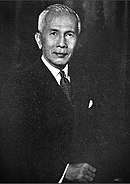
In February 1957, public opinion turned against Phibun at the end of his second term when his party was suspected of fraudulent practices during an election, including the intimidation of the opposition, buying votes, and electoral fraud. In addition, critics of Phibun accused him of a lack of respect for the Thai monarchy, as the anti-aristocratic prime minister had always sought to limit the role of the monarchy to a constitutional minimum and had taken on religious functions that traditionally belonged to the monarch. For example, Phibun led the celebrations of the 2500th anniversary of Buddhism in 1956/57 instead of the King Bhumibol Adulyadej, who was openly critical of Phibun . On 16 September 1957, Phibun was eventually overthrown in a coup d'etat by members of the Royal Thai Army under the command of Field Marshal Sarit Thanarat, who had earlier sworn to be Phibun's most loyal subordinate. Sarit was supported by many royalists who wanted to regain a foothold, and there were rumors that the United States was "deeply involved" in the coup.[15]
Phibun was then forced into exile after the coup, first fleeing to Cambodia, but later settled in Japan after Sarit's new regime rejected his requests to allow him to return to Thailand. In 1960, Phibun briefly travelled to India to be a monk in the Buddhist temple in Bodhgaya.
Death
Phibun died on 11 June 1964 from heart failure while in exile in Sagamihara, Kanagawa Prefecture, Japan. After his death, Phibun's ashes were transferred to Thailand in an urn and decorated with military honors in Wat Phra Sri Mahathat (also called "The Temple of Democracy") he had founded in Bang Khen.
Honours
Royal decorations of Thailand
Plaek Phibunsongkhram received the following royal decorations in the Honours System of Thailand:[16]
- 1911 -
_ribbon.svg.png)
- 1925 -
_ribbon.svg.png)
- 1932 -

- 1934 -
.svg.png)
- 1937 -
_ribbon.svg.png)
- 1938 -
_ribbon.svg.png)
- 1940 -
_ribbon.svg.png)
- 1941 -
_ribbon.svg.png)
- 1941 -
_ribbon.svg.png)
- 1942 -
_ribbon.svg.png)
- 1942 -

- 1943 -
_ribbon.svg.png)
- 1943 -
_ribbon.svg.png)
- 1943 -
.svg.png)
- 1944 -
_ribbon.svg.png)
- 1956 -
_ribbon.svg.png)
- 1957 -
_ribbon.svg.png)
Foreign honours
- 1939 -

- 1942 -

- 1955 -



Military rank
- Field Marshal, Admiral of the Fleet and Marshal of the Royal Thai Air Force[18]
Volunteer Defense Corps of Thailand rank
Academic rank
See also
References
- (in Thai) ผู้นำทางการเมืองไทยกับสงครามโลกครั้งที่ 2[df]: จอมพล ป.พิบูลสงคราม และ ปรีดี พนมยงค์ Archived 27 June 2008 at the Wayback Machine
- Batson, Benjamin Arthur; Shimizu, Hajime (1990). The Tragedy of Wanit: A Japanese Account of Wartime Thai Politics. University of Singapore Press. p. 64. ISBN 9971622467. Retrieved 29 September 2018.
- Ansil Ramsay (2001). Grant H. Cornwell; Eve Walsh Stoddard (eds.). The Chinese in Thailand: Ethnicity, Power and Cultural Opportunity Structures. Global Multiculturalism: Comparative Perspectives on Ethnicity, Race, and Nation. Rowman & Littlefield. p. 63.
- "man on horseback". The Free Dictionary. Retrieved 30 June 2011.
n. A man, usually a military leader, whose popular influence and power may afford him the position of dictator, as in a time of political crisis
- Numnonda, Thamsook (September 1978). "Pibulsongkram's Thai Nation-Building Programme during the Japanese Military Presence, 1941-1945". Journal of Southeast Asian Studies. 9 (2): 234–247. doi:10.1017/S0022463400009760. JSTOR 20062726.
- Churchill, Winston S. The Second World War, Vol 3, The Grand Alliance, p.548 Cassell & Co. Ltd, 1950
- "A Slice of Thai History: The Japanese invasion of Thailand, 8 December 1941" (part one)
- Ford, Daniel (June 2008). "Colonel Tsuji of Malaya (part 2)". Warbirds Forum. Retrieved 30 June 2011.
Though outnumbered two-to-one, the Japanese never stopped to consolidate their gains, to rest or regroup or resupply; they came down the main roads on bicycles.
- "The Swift Japanese Assault". National Archives of Singapore. 2002. Retrieved 30 June 2011.
Even the long legged Englishmen could not escape our troops on bicycles.
- "A Slice of Thai History: The Japanese invasion of Thailand, 8 December 1941" (part three)
- I.C.B Dear, ed, The Oxford companion to World War II (1995) p 1107
- Roeder, Eric (Fall 1999). "The Origin and Significance of the Emerald Buddha". Southeast Asian Studies. Southeast Asian Studies Student Association. 3. Archived from the original on 5 June 2011. Retrieved 30 June 2011.
Judith A. Stowe, Siam becomes Thailand (Honolulu: University of Hawaii Press, 1991), pp. 228-283
- Aldrich, Richard J. The Key to the South: Britain, the United States, and Thailand during the Approach of the Pacific War, 1929-1942. Oxford University Press, 1993. ISBN 0-19-588612-7
- สมศักดิ์ เจียมธีรสกุล: พูนศุข พนมยงค์ ให้สัมภาษณ์กรณีสวรรคต พฤษภาคม 2500
- Western Political Quarterly, Vol. 15, No. 1 (Mar., 1962), pp. 93-110
- Biography of Field Marshal P. Archived 26 August 2002 at the Wayback Machine, Royal Thai Army website. Retrieved on 4 December 2008.
- Royal Thai Government Gazette. แจ้งความสำนักนายกรัฐมนตรี เรื่อง ให้ประดับเครื่องราชอิสสริยาภรณ์ต่างประเทศ Vol. 56 Page 3594 on 11 March 1939
- http://www.ratchakitcha.soc.go.th/DATA/PDF/2484/A/981.PDF
- http://www.ratchakitcha.soc.go.th/DATA/PDF/2498/D/046/1.PDF
- http://www.ratchakitcha.soc.go.th/DATA/PDF/2482/D/809.PDF
Further reading
- Baker, Chris; Phongpaichit, Pasuk (2009). A History of Thailand (2nd ed.). Cambridge University Press. ISBN 9781139194877. Retrieved 29 September 2018.
- Staniczek, Lukasz (1999). Pibun Songkram 's Role in Thailand's Entry into the Pacific War (Thesis). Arkadelphia: Ouachita Baptist University. Retrieved 2 April 2020.
- Wyatt, David K. Thailand: A Short History, Yale University Press, 2004 ISBN 0-300-08475-7
External links
| Wikimedia Commons has media related to Plaek Pibulsonggram. |
- Duncan Stearn:A Slice of Thai History: The Japanese invasion of Thailand, 8 December 1941 (part one) (part two) (part three)
- Kopkuea Suwannathat-Phian (1989). Foreign Policies of Phibunsongkhram Government: 1938–1944 (pdf) (in Thai). Bangkok: Thammasat University Press. ISBN 9745724165.
| Political offices | ||
|---|---|---|
| Preceded by Phraya Phahol Pholphayuhasena |
Prime Minister of Thailand 1938–1944 |
Succeeded by Khuang Abhaiwongse |
| Preceded by Khuang Abhaiwongse |
Prime Minister of Thailand 1948–1957 |
Succeeded by Pote Sarasin |

